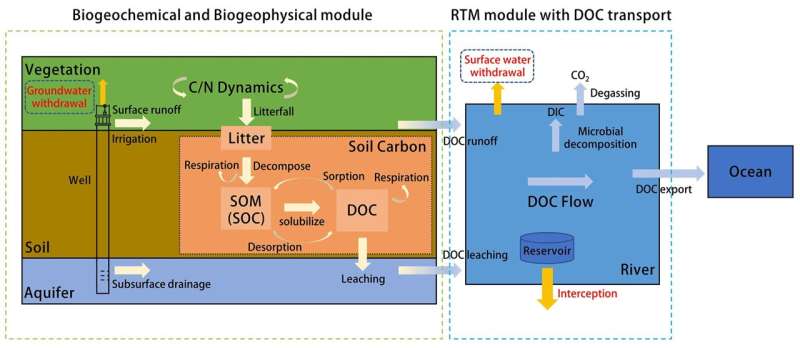This article has been reviewed according to Science X's editorial process and policies. Editors have highlighted the following attributes while ensuring the content's credibility:
fact-checked
peer-reviewed publication
trusted source
proofread
Revealing the role of anthropogenic water regulation in shaping riverine dissolved organic carbon fluxes

Riverine dissolved organic carbon (DOC) plays a crucial role in supporting microbial ecosystems in rivers and oceans while also contributing to greenhouse gas emissions from freshwater systems.
In recent years, human-driven water regulation activities have significantly disrupted natural processes within river basins, leading to alterations in hydrological and hydraulic dynamics and affecting material circulation and transport.
A collaborative research team led by the Institute of Atmospheric Physics (IAP) of the Chinese Academy of Sciences has developed innovative models that account for both soil and riverine DOC dynamics, as well as the influence of anthropogenic water regulation activities. These models have been integrated into the land surface model CLM5.0.
The study was published in Earth System Dynamics on Sept. 4.
"We conducted three sets of numerical simulations from 1981 to 2013 on a global scale using our developed model to investigate the effects of anthropogenic water regulation on riverine DOC transport," said Ph.D. candidate You Yanbin from IAP.
The researchers found that in the majority of cases, the transport of DOC in rivers was predominantly reduced by surface water regulation. Prof. Xie Zhenghui, co-corresponding author noted, "The total impact of anthropogenic water regulation reduced global annual riverine DOC exports to the ocean by approximately 13.36 ± 2.45 Tg C yr-1, and this effect increased from 4.83% to 6.20% during 1981–2013."
In addition, the greatest impact of anthropogenic water regulation activities was concentrated in the region from 23.5°N to 66°N because this zone contains the highest intensity of human water use activities.
"Our innovative scheme for simulating DOC exports from terrestrial to aquatic systems is pivotal in accurately estimating global carbon budgets," said Prof. Jia Binghao, co-corresponding author of the study.
More information: Yanbin You et al, Impacts of anthropogenic water regulation on global riverine dissolved organic carbon transport, Earth System Dynamics (2023). DOI: 10.5194/esd-14-897-2023
Journal information: Earth System Dynamics
Provided by Chinese Academy of Sciences





















